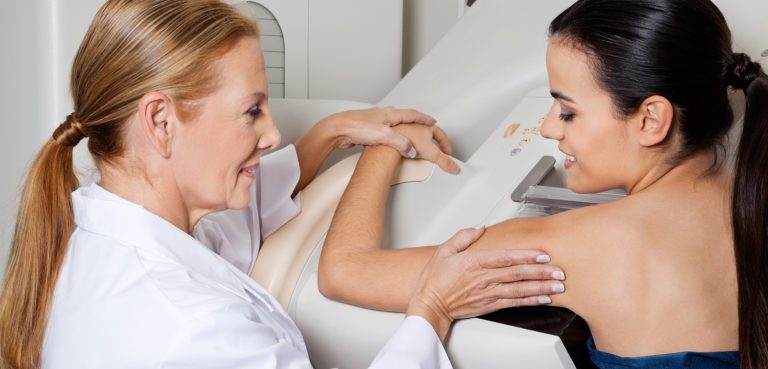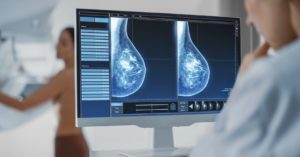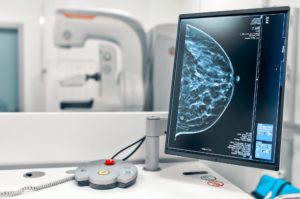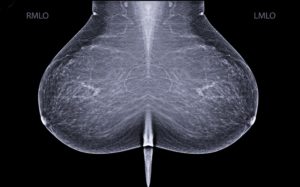The American Cancer Society and the American College of Radiology have developed guidelines shown below. Over 90% of breast cancers can be detected when all three methods are used together in a planned program. The following recommendations are for women who are considered at average risk for developing breast cancer.
AGE 20-24
1. Perform a breast self-exam once a month, 7-10 days after onset of menstruation.
2. Get an initial mammogram at age 40.
3. Get a physical exam at least every 3 years.
AGE 40+
1. Perform a breast self-exam once a month, 7-10 days after onset of menstruation.
2. Get a screening mammogram every year.
3. Get a physical exam every year.
Nearly half of all women have dense breast tissue, which refers to the amount of fibrous and glandular tissue compared to fatty tissue in the breast. Because dense tissue and tumors appear white on mammograms, additional imaging such as ultrasound or MRI may improve detection.
Digital 3D screening mammography is less effective at finding cancers in women with dense breasts, as the superimposition of breast tissue can obscure cancers or make normal structures appear suspicious. A conventional screening mammogram is the only early cancer detection strategy that has been shown in randomized trials to reduce the chance of death from breast cancer.
Fellowship-trained, subspecialty breast imaging radiologists will assess your breast density at the time of your screening mammogram using the Breast Imaging Reporting and Data System (BIRADS), developed by the American College of Radiology. If the radiologist determines that your breast tissue is dense, additional imaging might be considered to increase the likelihood of detecting early cancers.
Do not wear deodorant, lotion, powder or perfume under your arms or on your breasts on the day of your exam. These products can appear as white spots on the X-ray and interfere with the images.
Wear a two-piece outfit for convenience, and bring any prior mammogram results for comparison. Expect to spend about an hour at the facility.
During a screening mammogram, a skilled technologist gently positions each breast, one at a time, on a specialized X-ray platform. Your breast is gradually compressed to even out the breast tissue, which allows for clearer images and a lower X-ray dose. The entire exam usually takes about 20 to 30 minutes. You should expect to spend around 45 minutes to an hour at our facilities. A radiologist who specializes in breast imaging then carefully examines these images for any abnormalities, such as masses or microcalcifications, that may signal breast cancer.
Preparation for a diagnostic mammography is the same as for a screening mammography appointment.
– Expect to spend an hour to an hour and a half at the facility to complete the entire process. A radiologist will be reviewing your images in real time to determine if additional views are needed.
– Please do not wear deodorant, lotion, powder, or perfume under your arms or on your breasts the day of the procedure.
– Prior to your exam make not of any prior screening mammograms and the results (if your previous screening mammograms were performed at a facility other than Touchstone Medical Imaging).
A diagnostic mammogram takes longer and is more comprehensive, providing more detailed images. The technologist gets a closer, more detailed look at a specific area of concern, taking more images of the breast from various angles. A radiologist reviews the images in real time to determine if you need additional imaging, such as a breast ultrasound or MRI.
After your diagnostic mammogram, the radiologist will interpret your results in one of three ways:
The abnormal area seen on your screening mammogram is actually normal. You can return to your routine yearly screenings.
The area appears probably benign (not cancer), but the radiologist may want to monitor the area closely. We may recommend a follow-up mammogram in four to six months.
The images suggest further investigation with a biopsy to confirm whether the abnormal area is cancerous. Most biopsies come back negative for cancer.
Touchstone Medical Imaging performs diagnostic mammography exams at various locations in Texas. Please find a center using our location finder.
Your doctor may order a diagnostic mammogram if:
– Your screening mammogram shows something unusual
– You have dense breast tissue, which makes it harder to see abnormalities
– You have signs of breast cancer, such as a new lump, breast pain, skin dimpling or nipple discharge
Women with breast implants should continue to have regular mammograms. It is important to inform the facility of your implants when scheduling your appointment. The technologist will use special techniques to carefully position the implant to get clear images of the breast tissue without causing harm. Patients with implants often get a diagnostic mammogram for a more comprehensive evaluation.
Mammograms use a very low dose of radiation. The radiation for DBT may be slightly higher than that of a standard mammogram, but it remains within FDA-approved safety levels. The benefits of early detection far outweigh the minimal risks associated with this exposure.
Touchstone Imaging offers diagnostic mammography exams at various locations in Texas. Use the location finder to choose the most convenient center for you.
Do I need a referral for a screening mammogram?
No, you do not need a physician’s order for a screening mammogram. However, we require the doctor’s name who will receive your results.












